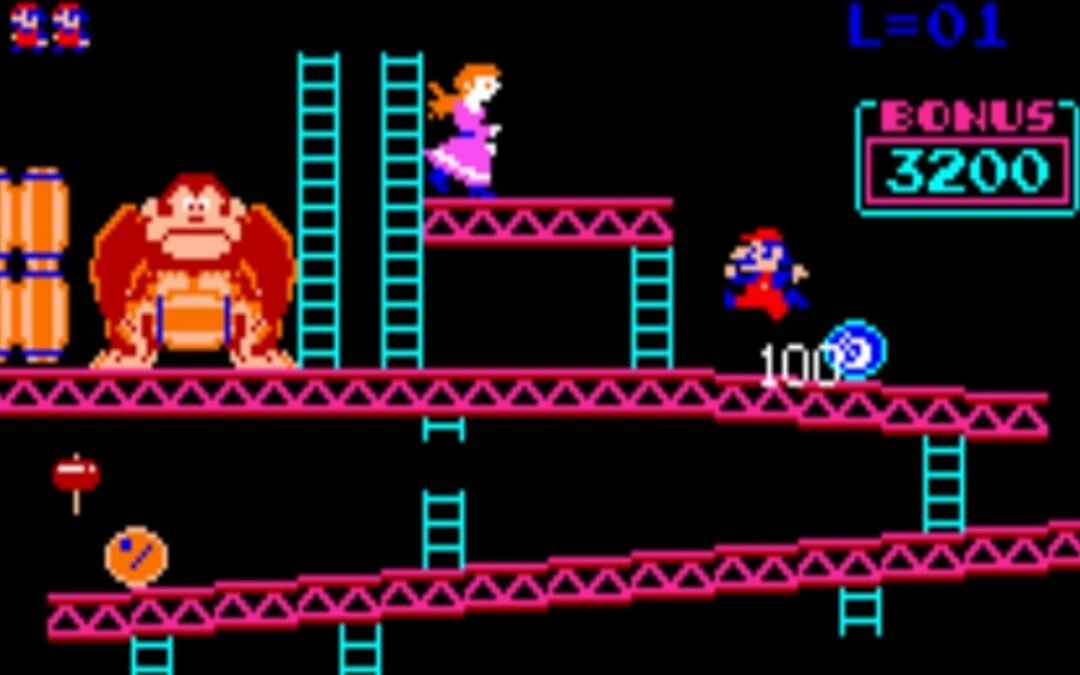Donkey King or Kong?
In the early 80’s, arcade games were all the rage, and having the best home port version often, and very sadly, lead to the belief that the system the ‘best’ version of a game was on was indeed, the best system. I distinctly remember arguing with classmates who felt the Apple II was far superior to the CoCo due to its version of Pacman (Sadly a good CoCo version of Pacman had yet to materialize – more on that to come).
In July of 1981, Nintendo released a video game many consider to be a quintessential classic video game – Donkey Kong. The goal of Donkey Kong is to help Mario (this was his first video game appearance – ever) navigate four levels of a building under construction to rescue Pauline from Donkey Kong.
Donkey Kong, to a much lesser extent than Pacman, took the arcades by storm. Virtually all computers and consoles, from the venerable Atari 2600 and Colecovision to the C64 and Atari 8-bitters and everything in between, had an officially licensed version waiting to be plucked off the shelf and played. Except, of course, the CoCo line. You see, Tandy in their infinite wisdom seldom got licensed versions of games. I can think of only a few: Zaxxon, Rampage, Frogger and Pitfall II are a few examples. No, instead we got game titles like Space Race (Omega Race), Monkey Kong and Dunkey Munkey (Donkey Kong), Lunar Rover Patrol (Moon Patrol) and Offender (Defender).
Not that I’m complaining, mind you, since I was very glad to even have some games to play. However, most of the CoCo games came via unlicensed, third party ports, which leads me back to Donkey Kong. As mentioned above, Dunkey Munkey and Monkey Kong were two ports made for the CoCo – but they weren’t very accurate to the arcade game – which was common for the CoCo back then. That changed in late 1982 when Tom Mix Software released a game called Donkey King – authored by Chris Latham (who was also responsible for several other arcade quality ports I’ll review in the future), for the 32k CoCo, on either cassette tape or floppy disk. The ad for it first appeared on page 40 of the December 1982 Rainbow Magazine:

Tom Mix Rainbow Ad
Obviously a clone of Nintendo’s Donkey Kong , it was very true and accurate to the arcade with the exception of colors and some sound effects. In hi-res screens, the CoCo relied on artifact colors to try to add some color depth to the screen, since its color
palette was very limited (see my CoCo1 article here or here for specs). Further, with no dedicated sound hardware included in the design, getting sound effects and music to play during a game relied on clever programming tricks by software authors who really understood the CoCo’s architecture.
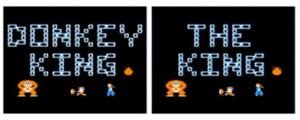
Donkey King was so close to the arcade version of the game, rumor has it that Tom Mix Software was threatened with a lawsuit over the game title and was force to change it from ‘Donkey King’ to ‘The King’ – hence there being two different title screens for the same game. Which one you got just depends on when the game was purchased. Obviously, since it was an unlicensed version, certain changes had to be made.
Now, most home versions of Donkey Kong differed from the arcade version in several ways. Usually, the home versions lacked a level and or intermissions and some music and sound effects. The most common difference, however, was the screen layout of one or more levels – for example the Colecovision version, considered by many to be the best home version regardless of the missing level, even had the sides of the screen reversed on Level 1. The VIC-20 and C64 versions had all of the levels and correct orientation; however, they too had height differences on the screen when compared to the arcade version.
Below are screenshots of the arcade and various home versions of Donkey Kong:
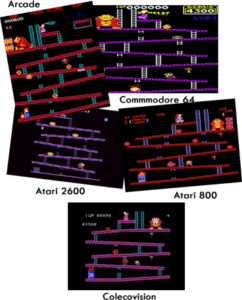
From the screenshots shown above, you can see some common differences between the arcade version and the console versions. I suspect this had to do with the vertical resolution of the home console versus the arcade machine. Whether that’s an acceptable reason or not, I’ll leave that to the individual retro fans to decide for themselves since it’s beyond the scope of this article.
Personally, I prefer the approach taken by Chris Latham, which appears to be one of shortening ladders here and there to achieve the most arcade like translation available for Donkey Kong or a clone at the time. If that was indeed his goal, in my opinion he succeeded.

In Level 1 and Level 2 of Donkey/The King you can see where Chris shortened the height of the ladders, and thus the height of the play field in general. Again, personal opinion here, but, I prefer this ideology to changing the layout and orientation of the game’s levels.

Chris did a great job ensuring all of the elements that made the arcade version a hit were present in Donkey/The King. All four levels – Barrels, Rivet, Elevator and Pie/Conveyor are present in the game. The other CoCo versions had varied levels of the game, but, Donkey/The King was the only one to have all four levels, arcade like sound effects and the intermissions from the arcade. And as I said earlier there were a number of officially licensed versions that didn’t have all four levels either.
Looking at how close Chris’s game is to the arcade, one wonders why Tom Mix never pursued an official license. There was a name change from Donkey King to The King, which gives credence to the rumor that Nintendo did, in fact, take notice of the game. No, the colors were not arcade accurate, but, neither were the colors for the C64 and Colecovision either – two versions that are often considered the best Donkey Kong ports.
As for the graphics, I’d have to say Donkey/The King was just as good as the other home ports as well. Also, the fact the game has the Rivet Level intermission (below), and all four levels gives the CoCo game a sense of completeness other home ports lacked.
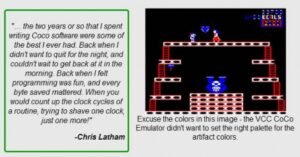
“The CoCo’s strong point was it’s CPU, of course, but also the fact that many abilities were software generated rather than limited to a specific set of hardware (a particular sound chip, sprite limitation, etc…) It meant more work and was highly dependent on the skill of the programmer, but it meant it was always possible to make something different or better.” – John ‘Sock Master’ Kowalski
Donkey/The King was a very good representation of Donkey Kong for the CoCo. The game was the rare exception when an unlicensed CoCo port was as good as or better than many of the other 8-bit home ports available at the time. Really, though, the story doesn’t end there. As you might have noticed, the article was titled ‘A Tale of Two Donkeys’ and there’s a reason for that. At the Chicago CoCoFest in 2007, a programming legend in the CoCo family made an earth-shattering statement with the release of his latest project. John ‘Sock Master’ Kowalski is well known for his ability to make the CoCo do things it theoretically it shouldn’t be able to. His demos are legendary and his Gloom FPS demo was the basic engine behind Nick Marentas’ awesome ‘Gate Crasher’ game (to be reviewed later).
“What did ‘Sock Master’ have up his sleeve for this CoCoFest?” That was the question being asked by many during the last month before the ‘Fest – and I was one of them asking. In short – Donkey Kong. Literally – it was Donkey Kong. John converted the Z-80 source code to 6809 assembly language. The areas that couldn’t be converted, he emulated on the CoCo. Now, the game will not run on a regular CoCo1 or CoCo2. In fact, it will not run on a stock CoCo3, either. In order to play Donkey Kong on a CoCo3, it must have at least 512k of RAM.”
As for the results of John’s hard work? Nothing short of spectacular.
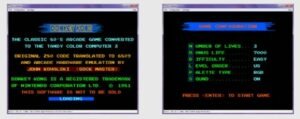
The load screen and game configuration screen are shown above. The configuration screen is self explanatory – you really can change all of those settings to tailor the game your skill level and CoCo3 configuration. An interesting fact about the game: while not coded to specifically take advantage of it, if the game detects a 6309 CPU in the CoCo3, it would kick the CPU in to native mode. This would give the game a bit of a performance boost over a stock 6809, but, it was coded to run fine on a CoCo3 with a 6809 – which it does quite well. In fact, I’ve noticed no difference in actual game play at all in my testing and playing over the years on 6309 & 6809 powered CoCo3’s.
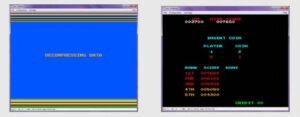
Data Decompression screen and high score screen: John’s CoCo3 version of Donkey Kong is highly compressed, therefore it does take some time to decompress – about 30 seconds I’d guess, though I have never actually timed it.
Once the game data is decompressed, the player is greeted to the Donkey Kong ‘High Score’ screen. In order to play the game, the player pushes the joystick button once to add a credit, then again to begin the game.

The Game Intro screen was maintained (naturally since it is the original code) with Donkey Kong carrying Pauline up the girders to start the Barrel Level. Since the game literally IS Donkey Kong, it’s nearly arcade perfect. Since the arcade has a taller vertical screen height (right image), John had to shorten the screens just a bit to compensate. (Which also appears to be the same idea Chris Latham had for Donkey/The King)
Other than differences in vertical height, this is nearly an arcade perfect translation – graphics, sounds and all.
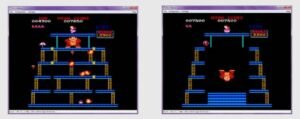
The Rivet Level is here – along with the intermission after the level is completed, with the full musical interlude:
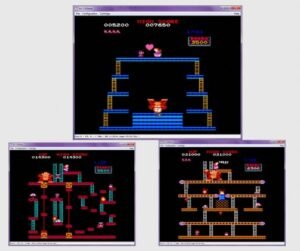
The elevator and conveyor/pie levels are here as well. Both are nearly arcade perfect – vertical screen height being the only difference. The job John did on his Donkey Kong conversion is nothing short of spectacular. When John set out to convert Donkey Kong to the CoCo3, his hope was it would inspire others to do similar conversions with other arcade games. Sadly, this has not happened yet. There were some conversions started, but, to my knowledge none have been completed.
In discussions with other retro computer fans over the years, many have said the CoCo3 version of Donkey Kong should not be considered as an entrant when discussing the best home versions of the game. My personal opinion is, why not? Yes, it came out years after official software stopped being developed for the system. So what? Yes, parts of the game are emulated. Again, so what? I think the more important question is this: could the same result have been achieved on other 8-bit platforms? That’s a question I’ll leave to retro fans everywhere to debate. I’d like to think the answer would be ‘yes’ – since I’m sure there was some pretty underutilized talent and hardware capabilities for all platforms of the day.
But when you boil it right down, when looking at the specs of the arcade Donkey Kong machine vs. the CoCo3, the quality of this game is a testament to not only John and his skills, but, also the CoCo3. It’s a remarkable computer that never ceases to amaze those of us who spent so much of our youth growing up with the machine.
This article first appeared in the now defunct ‘Retrogaming Times Monthly’ online magazine in 2013.

